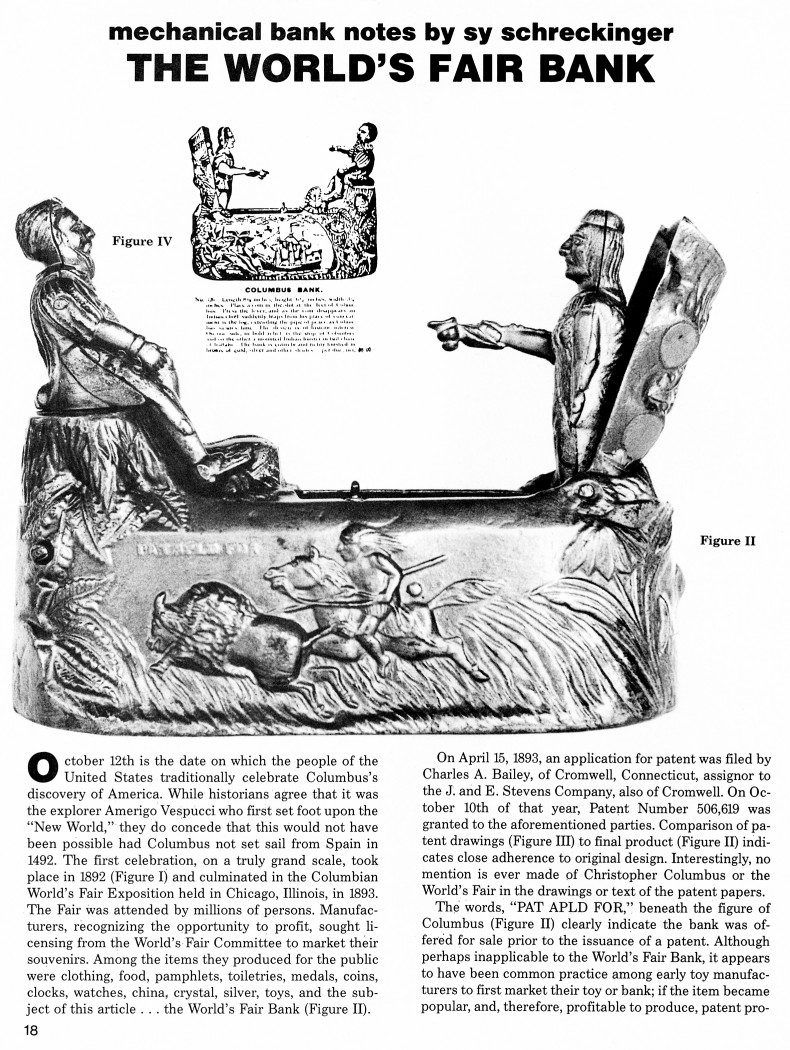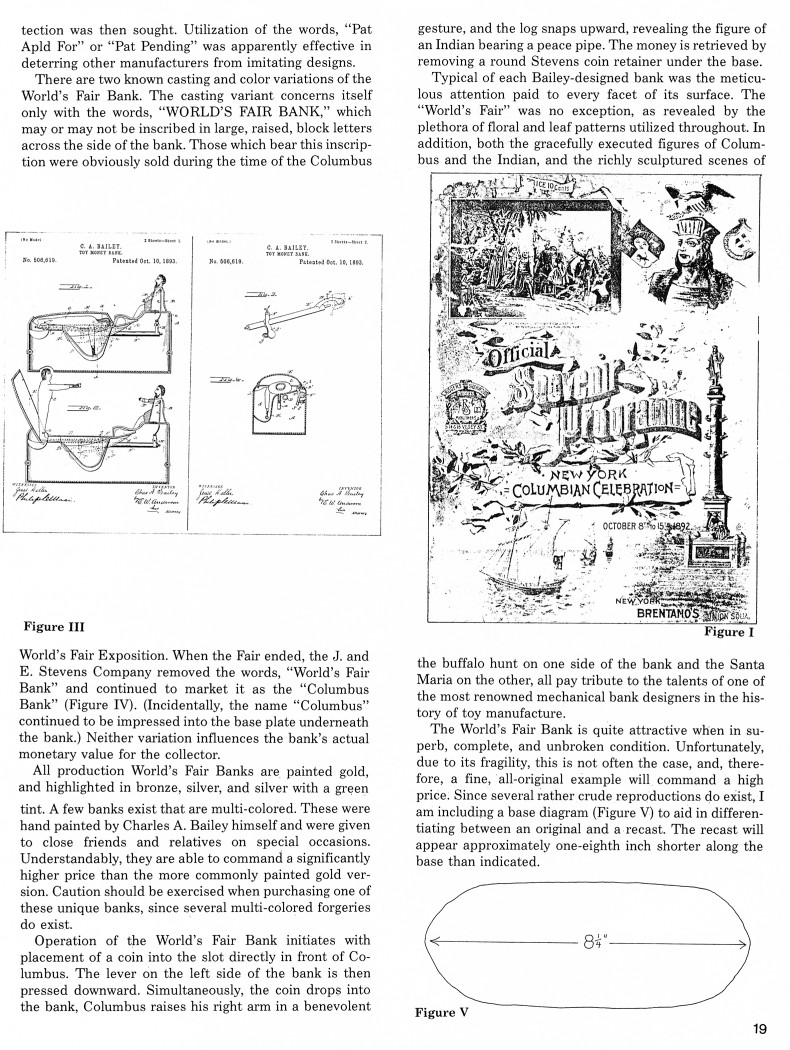|
The World's Fair Bank
by Sy Schreckinger – ANTIQUE TOY WORLD Magazine – February, 1989
October 12th is
the date on which the people of the United States traditionally celebrate
Columbus's discovery of America. While historians agree that it was the
explorer Amerigo Vespucci who first set foot upon the "New World," they do
concede that this would not have been possible had Columbus not set sail
from Spain in 1492. The first celebration, on a truly grand scale, took
place in 1892 (Figure I) and culminated in the Columbian World's Fair
Exposition held in Chicago, Illinois, in 1893. The Fair was attended by
millions of persons. Manufacturers, recognizing the opportunity to profit,
sought licensing from the World's Fair Committee to market their
souvenirs. Among the items they produced for the public were clothing,
food, pamphlets, toiletries, medals, coins, clocks, watches, china,
crystal, silver, toys, and the subject of this article ... the World's
Fair Bank (Figure II).
On April 15, 1893, an application for patent was filed by Charles A.
Bailey, of Cromwell, Connecticut, assignor to the J. and E. Stevens
Company, also of Cromwell. On October 10th of that year, Patent Number
506,619 was granted to the aforementioned parties. Comparison of patent
drawings (Figure III) to final product (Figure II) indicates close
adherence to original design. Interestingly, no mention is ever made of
Christopher Columbus or the World's Fair in the drawings or text of the
patent papers.
The words, "PAT APLD FOR," beneath the figure of Columbus (Figure II)
clearly indicate the bank was offered for sale prior to the issuance of a
patent. Although perhaps inapplicable to the World's Fair Bank, it appears
to have been common practice among early toy manufacturers to first
market their toy or bank; if the item became popular, and, therefore,
profitable to produce, patent protection was then sought. Utilization of
the words, "Pat Apld For" or "Pat Pending" was apparently effective in
deterring other manufacturers from imitating designs.
There are two known casting and color variations of the World's Fair
Bank. The casting variant concerns itself only with the words, "WORLD'S
FAIR BANK," which may or may not be inscribed in large, raised, block
letters across the side of the bank. Those which bear this inscription
were obviously sold during the time of the Columbus World's Fair
Exposition. When the Fair ended, the J. and E. Stevens Company removed the
words, "World's Fair Bank" and continued to market it as the "Columbus
Bank" (Figure IV). (Incidentally, the name "Columbus" continued to be
impressed into the base plate underneath the bank.) Neither variation
influences the bank's actual monetary value for the collector.
All production World's Fair Banks are painted gold, and highlighted
in bronze, silver, and silver with a green tint. A few banks exist that
are multicolored. These were hand painted by Charles A. Bailey himself and
were given to close friends and relatives on special occasions.
Understandably, they are able to command a significantly higher price than
the more commonly painted gold version. Caution should be exercised when
purchasing one of these unique banks, since several multi-colored
forgeries do exist.
Operation of the World's Fair Bank initiates with placement of a coin
into the slot directly in front of Columbus. The lever on the left side
of the bank is then pressed downward. Simultaneously, the coin drops into
the bank, Columbus raises his right arm in a benevolent gesture, and the
log snaps upward, revealing the figure of an Indian bearing a peace pipe.
The money is retrieved by removing a round Stevens coin retainer under the
base.
Typical of each Bailey-designed bank was the meticulous attention
paid to every facet of its surface. The "World's Fair" was no exception,
as revealed by the plethora of floral and leaf patterns utilized
throughout. In addition, both the gracefully executed figures of Columbus
and the Indian, and the richly sculptured scenes of the buffalo hunt on
one side of the bank and the Santa Maria on the other, all pay tribute to
the talents of one of the most renowned mechanical bank designers in the
history of toy manufacture.
The World's Fair Bank is quite attractive when in superb, complete,
and unbroken condition. Unfortunately, due to its fragility, this is not
often the case, and, therefore, a fine, all-original example will command
a high price. Since several rather crude reproductions do exist, I am
including a base diagram (Figure V) to aid in differentiating between an
original and a recast. The recast will appear approximately one-eighth
inch shorter along the base than indicated.
|


